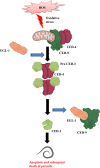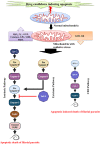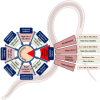Programmed cell death pathways as targets for developing antifilarial drugs: Lessons from the recent findings
- PMID: 37605891
- PMCID: PMC10538269
- DOI: 10.1111/jcmm.17913
Programmed cell death pathways as targets for developing antifilarial drugs: Lessons from the recent findings
Abstract
More than half a century has passed since the introduction of the National Filariasis Control Program; however, as of 2023, lymphatic filariasis (LF) still prevails globally, particularly in the tropical and subtropical regions, posing a substantial challenge to the objective of worldwide elimination. LF is affecting human beings and its economically important livestock leading to a crucial contributor to morbidities and disabilities. The current scenario has been blowing up alarms of attention to develop potent therapeutics and strategies having efficiency against the adult stage of filarial nematodes. In this context, the exploration of a suitable drug target that ensures lethality to macro and microfilariae is now our first goal to achieve. Apoptosis has been the potential target across all three stages of filarial nematodes viz. oocytes, microfilariae (mf) and adults resulting in filarial death after receiving the signal from the reactive oxygen species (ROS) and executed through intrinsic and extrinsic pathways. Hence, it is considered a leading target for developing antifilarial drugs. Herein, we have shown the efficacy of several natural and synthetic compounds/nanoformulations in triggering the apoptotic death of filarial parasites with little or no toxicity to the host body system.
Keywords: ROS; apoptosis; drug development; filariasis; oxidative stress.
© 2023 The Authors. Journal of Cellular and Molecular Medicine published by Foundation for Cellular and Molecular Medicine and John Wiley & Sons Ltd.
Conflict of interest statement
The authors declare that there is no conflict of interest.
Figures




References
-
- Mukherjee S, Joardar N, Babu SPS. Redox regulatory circuits as targets for therapeutic intervention of bancroftian filariasis: biochemical, molecular, and pharmacological perspectives. Oxidative Stress in Microbial Diseases. Springer; 2019:185‐208.
-
- Partono F. The spectrum of disease in lymphatic filariasis. Ciba Found Symp. 1987;127:15‐31. - PubMed
Publication types
MeSH terms
Substances
LinkOut - more resources
Full Text Sources

